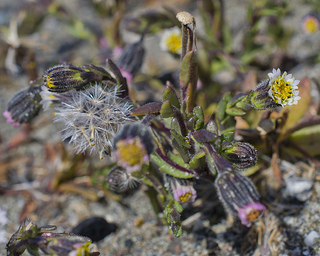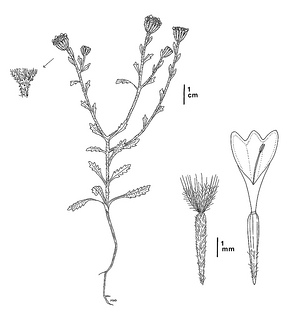(Layia carnosa)
 Layia carnosa. CDFW photo by Jeb Bjerke.
Layia carnosa. CDFW photo by Jeb Bjerke.
 Layia carnosa. CDFW illustration by Mary Ann Showers. (Click to enlarge)
Layia carnosa. CDFW illustration by Mary Ann Showers. (Click to enlarge)
Beach layia is a California endangered plant species, which means that killing or possessing this plant is prohibited by the California Endangered Species Act (CESA). Beach layia is a small and low-growing annual plant species that flowers April through July and is restricted to openings in coastal sand dune habitat. Beach layia is found at six isolated locations scattered along approximately 500 miles of the Northern and Central California coastline. Three locations are in Humboldt County at Freshwater Lagoon, Humboldt Bay, and at the mouth of the Mattole River; one location is in Marin County at Point Reyes National Seashore; one location is in Monterey County on the Monterey Peninsula; and one location is in Santa Barbara County at Vandenberg Air Force Base. Beach layia is also listed as an endangered species under the federal Endangered Species Act, and at the time of this page’s posting, the California Natural Diversity Database reported 16 occurrences of this species within the 6 locations described above that are presumed to still exist.
The threat of destruction or modification of beach layia habitat from development has been reduced since the species was listed. Approximately 91 percent of the estimated 450 acres of habitat known to support beach layia is now covered by conservation easements or is owned by federal, state, and local agencies, special districts, or non-governmental organizations with at least some management for conservation. Rare plant habitat restoration at Humboldt Bay North Spit (PDF) benefitting beach layia was conducted on behalf of CDFW with funds from California’s Rare and Endangered Species Tax Check-off Fund. Despite this success, the encroachment of invasive species and associated dune stabilization continue to be a major threat to beach layia. In addition, destruction of portions of habitat from climate change-associated ocean level rise may also be a threat to beach layia populations in Humboldt County.
Ongoing monitoring, invasive species removal, and habitat restoration are likely the most important components required for the conservation of the species, along with dedicated funding to carry these activities out. Acquisition and protection of the remaining unprotected habitat should also be pursued. Ocean level rising trends in beach layia habitat should be monitored and restoration efforts should also be focused within habitat with the least potential to be affected by ocean level rise.
CDFW may issue permits for beach layia pursuant to CESA, and you can learn more about the California laws protecting beach layia and other California native plants. Populations of beach layia occur in CDFW’s Northern Region, Bay Delta Region, Central Region, and South Coast Region. More information on beach layia is also available from the United States Fish and Wildlife Service Species Profile for Beach Layia.
Updated 1/17/2013